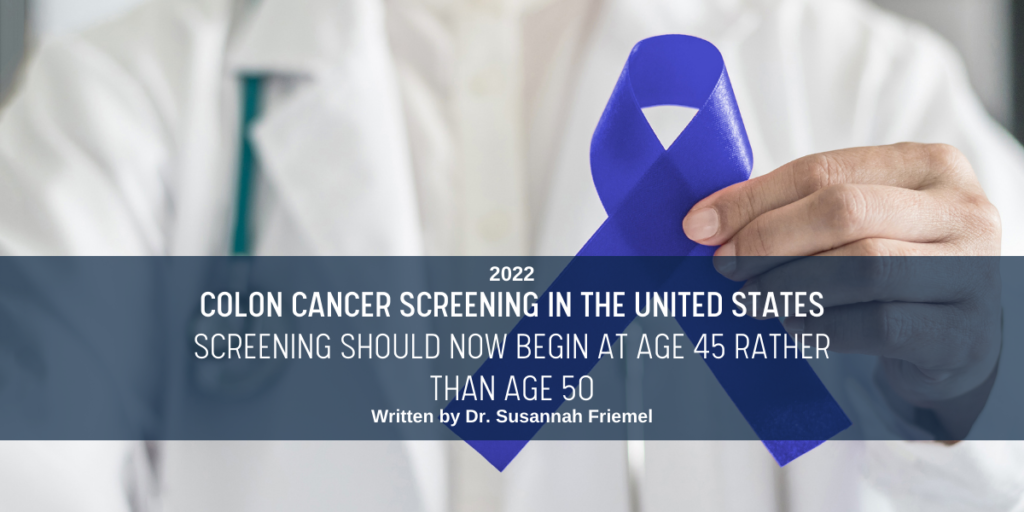Colon Cancer Screening in the United States

By Dr. Susannah Friemel
Colorectal cancer is the second leading cause of cancer death in Iowa (2022 Cancer in Iowa Report). The incidence of colorectal cancer in patients age 50+ has declined steadily since the mid-1980s, in part due to increased screening.
However, within the past two decades, there has been a concerning increase in colorectal cancer incidence among patients less than 50 years of age. In 2020, approximately 11% of colon cancers and 15% of rectal cancers occurred in individuals younger than 50 years old, compared with 5% and 9%, respectively in 2010 (American Cancer Society). The causes of this increase in what is called “young onset” colorectal cancer are unknown at this time.
Colorectal Cancer Screening
In May 2021, the U.S. Preventive Services Task Force (Task Force) lowered the recommended colorectal cancer screening age for average risk adults to age 45. According to the CDC, Adults older than 75 should talk to their doctor about screening. People at an increased risk of developing colorectal cancer should talk to their doctor about when to begin screening, which test is right for them, and how often to get tested. Factors that increase a person’s risk for colorectal cancer include:
- Inflammatory bowel disease such as Crohn’s disease or ulcerative colitis.
- A personal or family history of colorectal cancer or colorectal polyps.
- A genetic syndrome such as familial adenomatous polyposis (FAP) external icon or hereditary non-polyposis colorectal cancer (Lynch syndrome).
(Source: CDC’s “What Are the Risk Factors for Colon Cancer?”)
The Task Force is an independent panel of experts funded by the U.S. Department of Health and Human Services, which systematically reviews evidence of effectiveness of preventive health services and develops recommendations. American health insurance groups are required to cover at no charge to the patient any service recommended with a grade A or B level of evidence.
Several screening tests can be used to find polyps or colorectal cancer. The Task Force outlines the following colorectal cancer screening strategies. It is important to know that if your test result is positive or abnormal on some screening tests (stool tests like FIT, FIT-DNA, and Cologuard, flexible sigmoidoscopy, and CT colonography), a colonoscopy test is needed to complete the screening process. Talk to your doctor about which test is right for you.
View a Printable Guide to CRC Screening Tests
Stool Tests
- The guaiac-based fecal occult blood test (gFOBT)uses the chemical guaiac to detect blood in the stool. It is done once a year. For this test, you receive a test kit from your health care provider. At home, you use a stick or brush to obtain a small amount of stool. You return the test kit to the doctor or a lab, where the stool samples are checked for the presence of blood.
- The fecal immunochemical test (FIT)uses antibodies to detect blood in the stool. It is also done once a year in the same way as a gFOBT.
- The FIT-DNA test(also referred to as the stool DNA test) combines the FIT with a test that detects altered DNA in the stool. For this test, you collect an entire bowel movement and send it to a lab, where it is checked for altered DNA and for the presence of blood. It is done once every three years.
- How often: Every year.
Flexible Sigmoidoscopy
- For this test, the doctor puts a short, thin, flexible, lighted tube into your rectum. The doctor checks for polyps or cancer inside the rectum and lower thirdof the colon.
- How often: Every 5 years, or every 10 years with a FIT every year.
Colonoscopy
- This is similar to flexible sigmoidoscopy, except the doctor uses a longer, thin, flexible, lighted tube to check for polyps or cancer inside the rectum and the entire During the test, the doctor can find and remove most polyps and some cancers. Colonoscopy also is used as a follow-up test if anything unusual is found during one of the other screening tests.
- How often: Every 10 years (for people who do not have an increased risk of colorectal cancer).
CT Colonography (Virtual Colonoscopy)
- Computed tomography (CT) colonography, also called a virtual colonoscopy, uses X-rays and computers to produce images of the entire colon, which are displayed on a computer screen for the doctor to analyze.
- How often: Every 5 years.
How Do I Know Which Screening Test Is Right for Me?
Each test has advantages and disadvantages. Talk to your doctor about the pros and cons of each test, and how often to be tested. Which test to use depends on—
- Your preferences.
- Your medical condition.
- Your personal or family history of colorectal cancer or colorectal polyps.
- If you have a genetic syndrome such as familial adenomatous polyposis (FAP) or hereditary non-polyposis colorectal cancer (Lynch syndrome).
- The likelihood that you will get the test.
- The resources available for testing and follow-up.
Barriers & Opportunities
Despite the proven benefits of colorectal cancer screening, it’s estimated only 68% of eligible individuals in the United States undergo screening; the rate is lower among the uninsured and under insured, those with low incomes and in racial/ethnic minorities. Barriers to screening include lack of knowledge of importance of screening, concerns about the invasive nature of some procedures, lack of provider recommendations for screening, and logistical challenges such as transportation and time off.
Specific actions employers can take to help close the gaps in colorectal cancer incidence and mortality include providing employees 45 years of age and older with a paid “wellness day” to undergo recommended cancer screening, or offer daycare or transportation incentives to help overcome the logistical hurdles of completing a cancer screening. Specific actions healthcare providers can take include patient reminders, provider reminders and recall systems, giving a strong provider recommendation for cancer screening, and offering weekend or after-hours appointments for in-office procedures such as colonoscopies.
Additional Resources
- Iowa Get Screened – Colorectal Cancer Program
- Iowa Cancer Consortium Colorectal Cancer Workgroup (email Rachel Schramm at [email protected] for more information)
- National Colorectal Cancer Roundtable
 Dr. Susannah Friemel serves on the Iowa Cancer Consortium Board of Directors and is the owner and President of Iowa Cancer Specialists in Davenport, IA where she practices hematology/oncology. Dr. Friemel is passionate about cancer prevention and early detection through cancer screening. Additionally, she is President-Elect of the Iowa Oncology Society and serves on the Executive Committee for the Scott County Medical Society.
Dr. Susannah Friemel serves on the Iowa Cancer Consortium Board of Directors and is the owner and President of Iowa Cancer Specialists in Davenport, IA where she practices hematology/oncology. Dr. Friemel is passionate about cancer prevention and early detection through cancer screening. Additionally, she is President-Elect of the Iowa Oncology Society and serves on the Executive Committee for the Scott County Medical Society.
